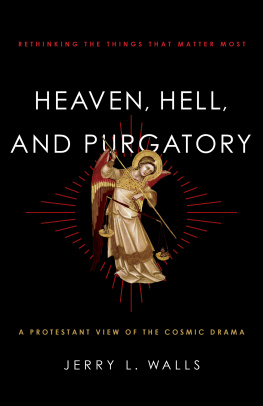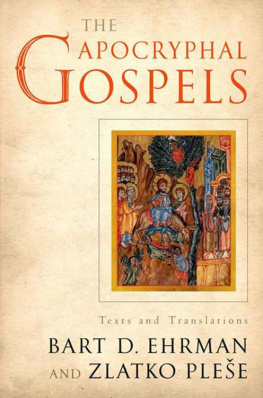JOURNEYS TO HEAVEN AND HELL
JOURNEYS TO HEAVEN AND HELL
Tours of the Afterlife in the Early Christian Tradition
BART D. EHRMAN
Yale
UNIVERSITY PRESS
New Haven and London
Published with assistance from the Louis Stern Memorial Fund.
Copyright 2022 by Bart D. Ehrman.
All rights reserved.
This book may not be reproduced, in whole or in part, including illustrations, in any form (beyond that copying permitted by Sections 107 and 108 of the U.S. Copyright Law and except by reviewers for the public press), without written permission from the publishers.
Yale University Press books may be purchased in quantity for educational, business, or promotional use. For information, please e-mail (U.K. office).
Set in Janson type by Newgen North America.
Printed in the United States of America.
Library of Congress Control Number: 2021942673 ISBN 978-0-300-25700-7 (hardcover : alk. paper)
A catalogue record for this book is available from the British Library.
This paper meets the requirements of ANSI/NISO Z39.48-1992 (Permanence of Paper).
10 9 8 7 6 5 4 3 2 1
To Radd
Who shares my name, my birthday, and my love of antiquity
Contents
Acknowledgments
I HAVE SPENT A good deal of my life thinking about heaven and hell; these past four years have been especially intense. I thank the institutions and individuals who have helped me reach the happy end of this particular literary adventure, a virtual katabasis. As the Sibyl says, going into the under world is easyno effort required. But to retrace your step and escape to the air above, this is the toil, this the labor (hoc opus, hic labor est; Aen. 6.12829).
At an early stage of my work, I applied for funding and am highly grateful to have received it. In 20182019 I was awarded a fellowship at the National Humanities Center. This is one of the great institutions supporting the humanities not just in the country but in the world. My thanks to Robert Newman, President and Director of the NHC; to all the staff, who were helpful beyond words; and to my fellow fellows for the year, with whom I enjoyed hours of food, drink, and dialogue, intellectual and otherwise, intercalated among long periods of research solitude.
That same year I was also awarded a Guggenheim Fellowship, and the administration of the foundation kindly allowed me to defer it for twelve months so that I could accept the offer from the NHC as well. The Guggenheim, obviously, is one of the truly great fellowships available to academics in an enormous range of fields. I know of none better. I am deeply thankful for having received it.
Finally, the University of North Carolina at Chapel Hill, my beloved home institution, generously allowed me to accept both fellowships, giving me two solid years of relief from teaching and administrative duties to devote to research. In particular, I thank Terry Rhodes, Dean of the College of Arts and Sciences; Elizabeth Engelhardt, Senior Associate Dean of Fine Arts and Humanities; Barbara Ambrose, our long-suffering chair of the Department of Religious Studies; and all of my colleagues in the department, an impressive array of scholars and teachers with whom I am proud to be associated.
Special thanks go to individuals who helped me with the research and writing of the book. Because of the wide range of texts and traditions involved I asked well-established experts in various fields to read appropriate sections for suggestions and comments. They did so with enthusiasm, both improving the book and saving me from numerous faux pas. Some of these Ive known for a long time; all of them, now, are friends for life:
Janet Downie, Associate Professor of Classics, University of North Carolina at Chapel Hill
Mark Goodacre, Frances Hill Fox Professor of Religious Studies, Duke University
Zbigniew Izydorczyk, Professor of English, University of Winnipeg
Sarah Isles Johnston, College of Arts and Sciences Distinguished Professor of Religion, The Ohio State University
James OHara, George L. Paddison Professor of Latin, University of North Carolina at Chapel Hill
David Reeve, Delta Kappa Epsilon Distinguished Professor of Classics, University of North Carolina at Chapel Hill
Loren T. Stuckenbruck, Professor, Evangelisch-theologische Fakultt, Ludwig-Maximilians-Universitt Mnchen
Two of my oldest and dearest friends who have broad expertise in New Testament studies but have never (till now) been heavily invested in ancient katabasis performed a work of supererogation by reading the entire manuscript with the eyes of highly trained professionals in a cognate field. This was a significant labor of love. On the other hand, they owe me, since I introduced them over two decades ago:
Jeffrey Siker, Professor of Biblical Studies, emeritus, Loyola Marymount University
Judy Siker, Vice President and Professor of New Testament, emerita, San Francisco Theological Seminary
In addition, five seasoned scholars with deep expertise in the broad range of this material generously read and shared their knowledge in comments on the entire manuscript, making numerous suggestions to improve the work and help me save face.
Harry Attridge, Sterling Professor of New Testament, emeritus, Yale Divinity School
Jan Bremmer, Professor of Religious Studies and Theology, emeritus, University of Groningen
Tobias Nicklas, Professor of New Testament Studies at the Faculty of Catholic Theology andof particular importance for this projectDirector of the Beyond Canon Centre, University of Regensburg, Germany
Pierluigi Piovanelli, Professor of Classics and Religious Studies, Faculty of Arts, University of Ottawa
Zlatko Plese, my colleague and friend, Professor of Religious Studies, University of North Carolina at Chapel Hill
I also thank my current PhD student and research assistant, Michelle Freeman, who undertook a number of investigative projects connected with the work and made helpful comments on the chapters. Michelle is industrious and insightful; you will be hearing more from her.
In addition I thank the members of a reading group I have been running for lo these many years. The group is named Christianity in Antiquity and so, of course, we call it the CIA. It comprises graduate students and faculty from both UNC and Duke working in (or around) New Testament studies and early Christianity. Once a month we spend an often intense evening over assorted beverages to discuss a paper one of us has produced. On two occasions over the past year the group has engaged with selections from my book; each time I survived the onslaught, and the book emerged better for it.
I am especially grateful to Jennifer Banks, my editor at Yale University Press, whom Ive known for years but now, at last, I have had a chance to work with. It has been a very pleasant experience indeed. Jennifer was excited about the book when she first heard of it, she enthusiastically pursued the possibility of publishing it, and throughout the process she has been inordinately helpful. May her editorial tribe increase.
Finally, two of my readers have long been part of my life. First is Sarah T. Beckwith, Katherine Everett Gilbert Distinguished Professor of English at Duke University, not only my beloved partner but also an inordinately passionate intellectual and the best reader of texts I know. Sarah has yet again made unusually insightful comments on my work and helped me see things I never would have seen on my own.
Second is my brother, Radd K. Ehrman, Professor of Classics at Kent State University, who has been reading Homer and Virgil since I was playing Little League and has never refused a plea for help on philological obscurities. Radd has thought about katabasis since taking a graduate seminar on the topic back in the 1970s, and he has a personal interest in visionary experience in general, as the translator of three volumes of Hildegard of Bingen (Oxford University Press). I dedicate the book to him.











